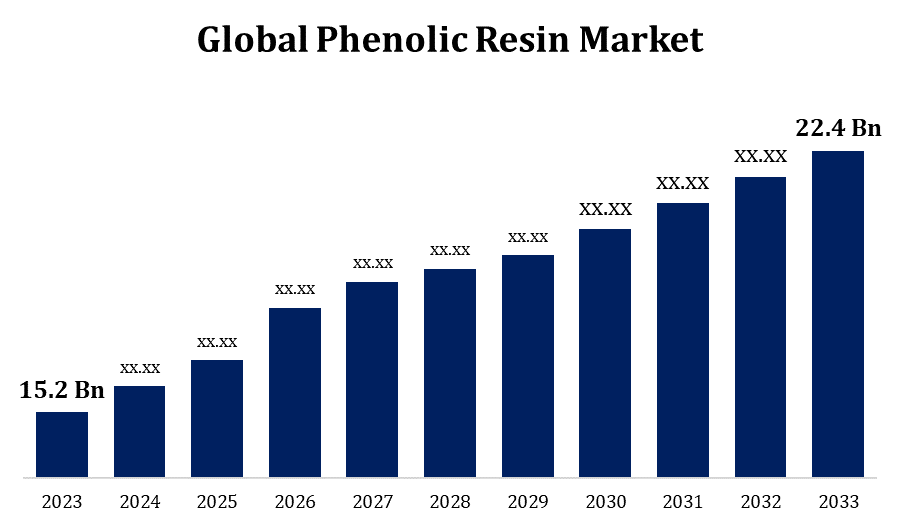Global Phenolic Resin Market Size To Worth USD 22.4 Billion By 2033 | CAGR of 3.95%
Category: Chemicals & MaterialsThe global phenolic resins market will reach a volume of 22.4 billion USD by 2033
According to a research report published by Spherical Insights & Consulting, the global phenolic resins market is expected to Grow from USD 15.2 billion in 2023 to USD 22.4 Billion by 2033 during the forecast period, growing at a compound annual growth rate (CAGR) of 3.95%.

Get more details on this report -
Browse key industry insights across 200 pages of 120 market data tables and figures & charts from the report on “ Global Phenolic Resins Market Size by Product (Novolac, Resol), by Application (Wood Adhesives, Moldings, Insulation, Laminates), by Region and Segment Forecasts, by Geographic Scope and Forecast to 2033.” Get a detailed report description here: https://www.sphericalinsights.com/reports/phenolic-resin-market
Due to its wide range of applications across a variety of industries, the phenolic resin market has grown significantly over the years. Its high heat resistance, mechanical strength and electrical properties make it a popular choice. Demand is significantly influenced by the automotive, construction, electronics and aerospace industries. Phenolic resins have found new applications as the focus on lightweight and high-performance materials has increased. The desire for eco-friendly and sustainable materials has also led to the development of bio-based phenolic resins, which have added a new dimension to the industry. Urbanization, infrastructure development and technological advancements are likely to lead to significant growth.
Analysis of the value chain of the phenolic resin market
The first step in the journey is the extraction or synthesis of raw materials. Phenol and formaldehyde are important components of phenolic resins. These are mostly derived from petrochemical sources, while bio-based alternatives are being explored. Phenolic resins are formed by the chemical reaction of phenol and formaldehyde. Polymerisation produces a thermosetting resin with the desired properties. The synthesized resin is then processed and formed into various forms, such as liquid resins, powder resins or molded parts, depending on the intended function. Once manufactured, phenolic resins are distributed to a variety of industries through a network of suppliers, distributors and logistics providers. Many industries use phenolic resins, including the automotive, construction, electronics and aerospace industries.
Analysis of market opportunities for phenolic resins
Phenolic resins are in high demand in the automotive, construction, electronics and aerospace industries. As these industries grow, so does the demand for high-performance materials such as phenolic resins. Phenolic resins offer great opportunities as the automotive and aerospace industries increasingly focus on lightweight materials for fuel efficiency. Their lightweight, yet robust and durable properties make them a tempting replacement for heavier materials. Phenolic resins are important components of composite materials. There is scope for innovation in developing novel composite materials with improved properties such as increased fire resistance, thermal stability or strength. Exploring opportunities in emerging markets and industrializing regions could be a smart strategic move.
Vehicle manufacturers are increasingly focusing on reducing vehicle weight to improve fuel efficiency and meet strict environmental regulations. Phenolic resins, which are lightweight but strong and durable, are used in a wide range of applications including composites and lightweight components. Phenolic resins provide thermal insulation. They are widely used in the automotive sector to produce heat-resistant components such as brake components. Phenolic resins are widely used in the automotive industry as adhesives and binders. They have excellent bonding properties that contribute to the structural integrity of the vehicle. The use of phenolic resins in the manufacture of electrical components is increasing as vehicles become increasingly electrified.
Phenolic resin production depends on raw materials such as phenol and formaldehyde, the cost of which can fluctuate due to factors such as oil price fluctuations. This can impact the overall manufacturing costs and profit margins of phenolic resin manufacturers. Other materials and resins with equivalent or better properties compete in the market. Manufacturers must innovate and continually improve the performance of phenolic resins to maintain their competitive advantage. End users may not be aware of the benefits and applications of phenolic resins despite their numerous properties. Educating potential customers about the benefits of phenolic resins and promoting their capabilities can help increase demand. The phenolic resin industry, like many others, is vulnerable to supply chain disruptions.
Insights by product
The novolak segment accounted for the largest market share during the forecast period 2023-2033. Novolak phenolic resins are widely known for their thermal and chemical resistance. This property qualifies them for use in industries where heat and chemical resistance is required, such as paints, adhesives, and molding compounds. Novolak resins are widely used in adhesives and coatings that require high temperatures and durability. These applications are found in a variety of industries, including aerospace and automotive manufacturing. The demand for novolak phenolic resins has increased due to the rise of end-use industries such as automotive, aerospace, and electronics. The demand for specialty materials with customized properties is expected to increase with the development and expansion of these industries.
Insights by application
The molding segment accounted for the largest market share during the forecast period 2023 to 2033. Phenolic resins are well suited to molding techniques such as compression molding and injection molding. This versatility enables manufacturers to produce a wide range of molded parts for a variety of industries. The electrical insulating properties of phenolic resins are widely known. Due to their superior electrical insulation, phenolic resins are chosen in molding applications for electrical components such as interconnects, switches, and insulators. The automotive industry is a major contributor to the expansion of the phenolic molding segment. Many automotive components such as brake components, engine parts, and interior components are molded using phenolic resins. Phenolic resins are used to manufacture consumer products such as handles, buttons, and other components.
Insights by region

Get more details on this report -
North America is expected to dominate the phenolic resins market from 2023 to 2033. The region's market has been growing gradually, driven by demand from key industries such as automotive, construction, electronics, and aerospace. The robust automotive sector in North America has greatly increased the need for phenolic resins. Lightweighting efforts, combined with the need for heat-resistant and durable materials, have increased the use of phenolic resins in the manufacturing of many auto components. The North American construction industry has significantly increased the demand for phenolic resins. These resins are used in laminates, insulation materials, and construction adhesives.
Asia Pacific to witness the fastest market growth between 2023 and 2033. The phenolic resins market in Asia Pacific has been growing at a rapid pace. The demand for phenolic resins has increased due to industrialization, infrastructure development, and economic growth in countries such as China, India, Japan, and South Korea. Asia Pacific is a manufacturing giant in a variety of industries including automotive, electronics, construction, and consumer goods. The need for phenolic resins in various industries for applications such as adhesives, coatings, and composites has been a major driver of the market growth. Increasing urbanization and infrastructure development in Asia Pacific have increased the demand for phenolic resins in the construction sector. These resins are used in a variety of construction applications including laminates, insulation materials, and adhesives.
Current market developments
- In July 2022, DIC Corporation acquired Guangdong TOD New Material Co., Ltd., a Chinese coated resin manufacturer.
Major players in the market
- DIC CORPORATION
- Kolon Industries, Inc.
- Sumitomo Bakelite Co. Ltd.
- Hexcel Corporation
- Georgia Pacific Chemicals GmbH
- KRATON CORPORATION
- Hexion
- Bostik, Inc.
- SI Group, Inc.
Market segmentation
This study forecasts revenue at global, regional and country levels from 2023 to 2033.
Phenolic resin market, product analysis
- Novola
- resolve
Phenolic resin market, application analysis
- Wood adhesives
- Forms
- Insulations
- Laminate
Phenolic Resin Market, Regional Analysis
- North America
- US
- You have
- Mexico
- Europe
- Germany
- United Kingdom
- France
- Italy
- Spain
- Russia
- Rest of Europe
- Asia-Pacific
- China
- Japan
- If
- South Korea
- Australia
- South America
- Brazil
- Argentina
- Colombia
- Middle East and Africa
- United Arab Emirates
- Saudi Arabia
- South Africa
About the Spherical Insights & Consulting
Spherical Insights & Consulting is a market research and consulting firm which provides actionable market research study, quantitative forecasting and trends analysis provides forward-looking insight especially designed for decision makers and aids ROI.
Which is catering to different industry such as financial sectors, industrial sectors, government organizations, universities, non-profits and corporations. The company's mission is to work with businesses to achieve business objectives and maintain strategic improvements.
CONTACT US:
For More Information on Your Target Market, Please Contact Us Below:
Phone: +1 303 800 4326 (the U.S.)
Phone: +91 90289 24100 (APAC)
Email: inquiry@sphericalinsights.com, sales@sphericalinsights.com
Contact Us: https://www.sphericalinsights.com/contact-us
Follow Us: LinkedIn | Facebook | Twitter
Need help to buy this report?